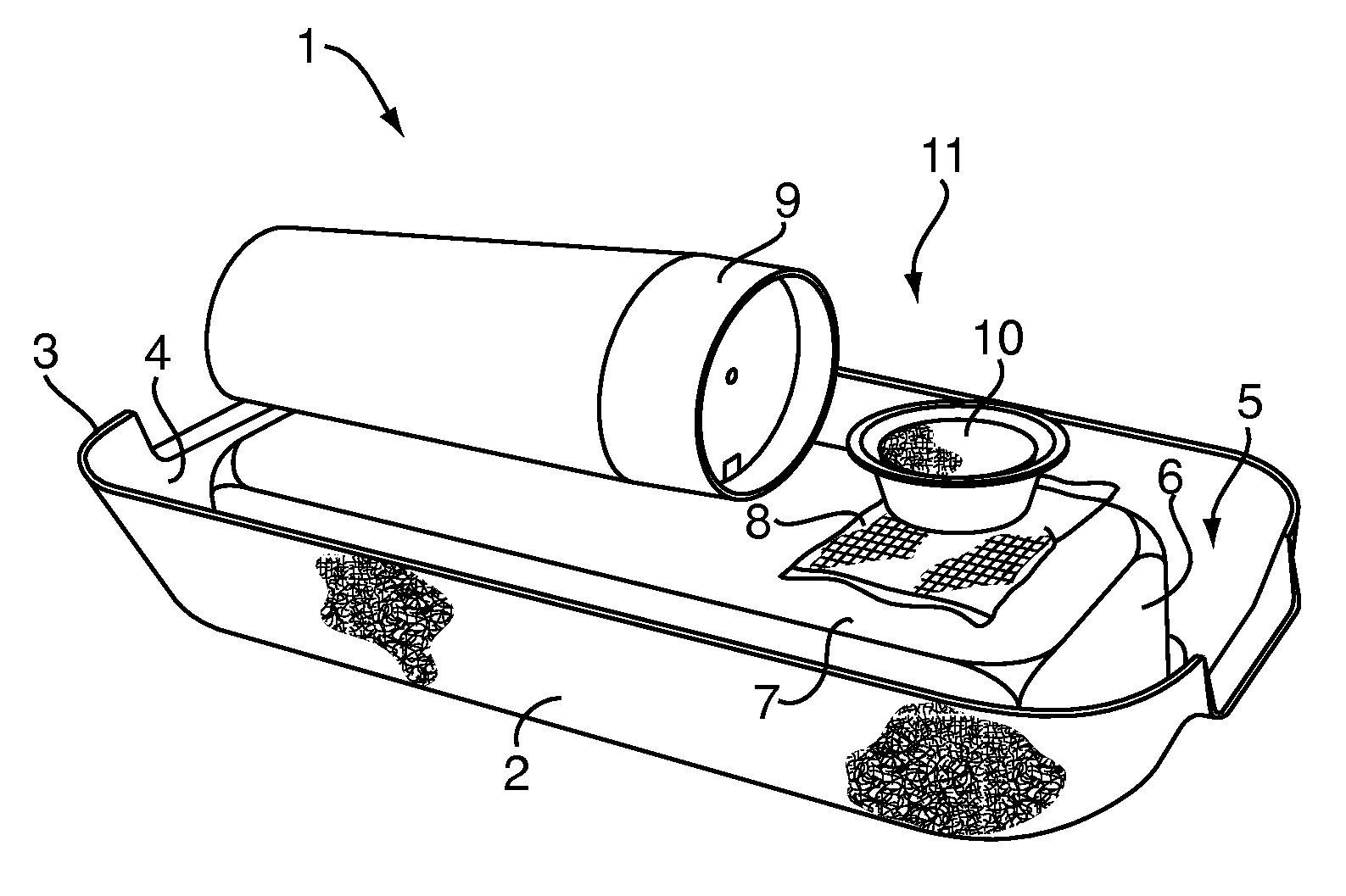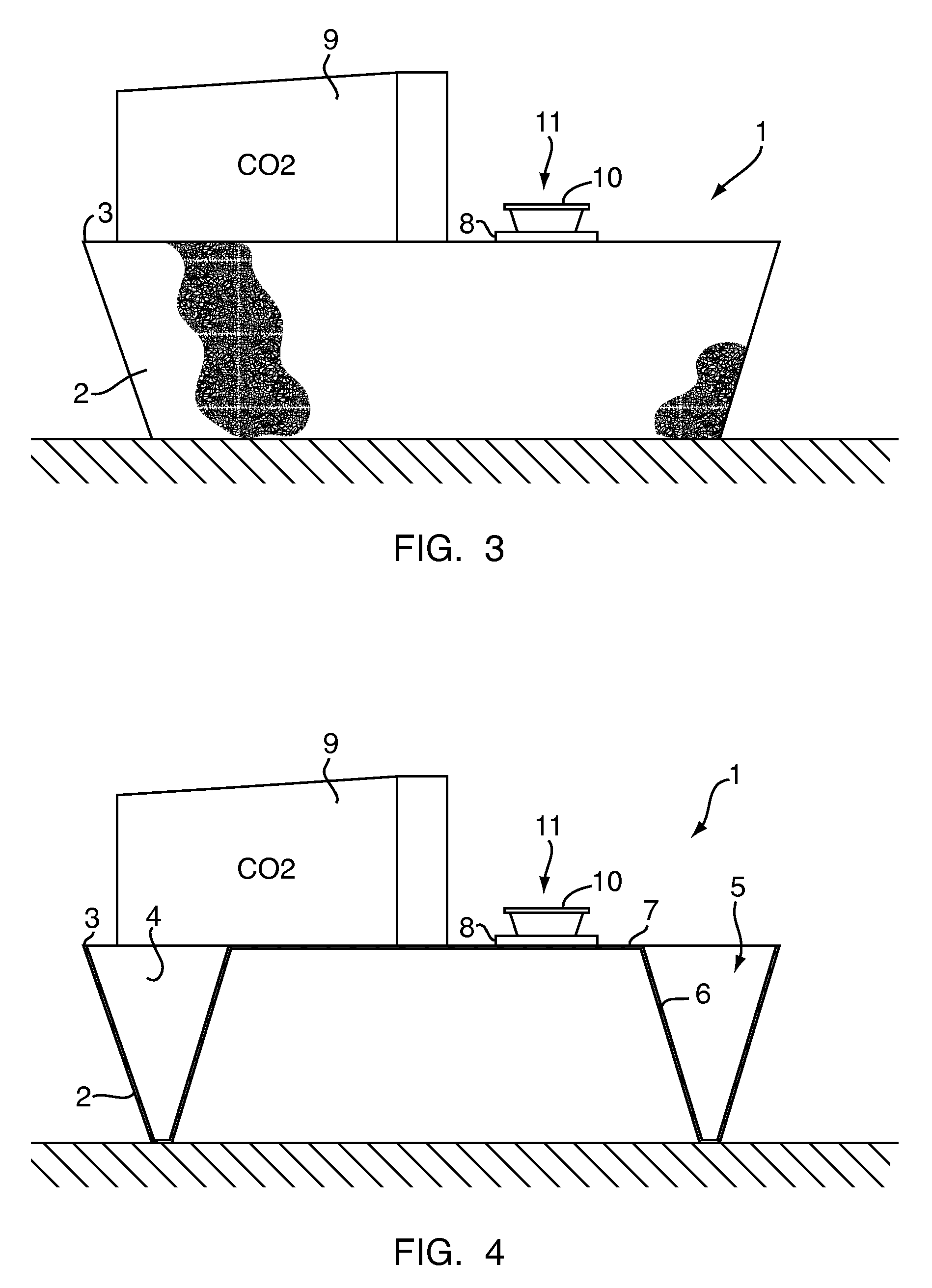Trap for bed bugs and the like
a technology for trapping and bed bugs, applied in the field of insect removal traps, can solve the problems of bed bugs, rising threat to the commercial health of resort hotels, bed bugs, and bed bugs
- Summary
- Abstract
- Description
- Claims
- Application Information
AI Technical Summary
Problems solved by technology
Method used
Image
Examples
example 1
[0057]A molded polypropylene dog dish was turned upside down to form a climb-up pitfall trap 1 as shown in FIG. 1. The exterior surface 2 was covered with cloth, the cloth being attached by masking tape, to form a climbing surface. Precipice 3 was formed by the outer edge of the dog dish. Interior surface 4 was formed by the underside of the outer rim of the dog dish which faces upward when the dog dish is turned upside down. Receptacle 5 was formed along the inside of the precipice 3 by the interior surface 4 and the retaining surface 6, effectively forming a capture moat area. The retaining surface 6 was formed by the underside of the inner bowl walls of the dog dish. Center stage 7 was formed by the underside of the bowl portions of the dog dish.
[0058]The trap 1 was positioned on the floor of an apartment building known to be infested by bed bugs.
[0059]Referring to the chronological chart of FIG. 5, the trap 1 was initially loaded with a heat blanket (heat source 8) alone. The he...
example 2
Experimental Lure Composition
[0063]A molded polypropylene dog dish was turned upside down to form climb-up pitfall trap 1 as described in Example 1. The exterior surface 2 was covered with Pellon® featherweight fusible interfacing to form a climbing surface. The surface of the receptacle 5 had a satin finish and was measured using a Mahr Federal Pocket Surf III probe to reveal a surface roughness of 33 to 96 microinch.
[0064]The trap 1 was positioned on the floor of an apartment building known to be infested by bed bugs.
[0065]As indicated in the bar chart of FIG. 6, the trap 1 was loaded with a heat blanket (heat source 8). The heat blanket generated temperatures of 44.8 to 47.3 degrees Celsius (112.6 to 117.1 degrees Fahrenheit). The trap with heat source 8 was tested several times for 14 days with a modest mean trap count. This test served as a control test.
[0066]The trap was then loaded with an octenol lure without L-lactic acid. The heat blanket again generated heat. The trap wit...
example 3
Carbon Dioxide Synergism With Experimental Lure Composition
[0069]A molded polypropylene dog dish was turned upside down to form the climb-up pitfall trap 1 as described in Example 2.
[0070]The trap 1 was positioned on the floor of an apartment building known to be infested by bed bugs, and was tested without any lure. This served as the control test illustrated as Test 6 in FIG. 7.
[0071]The trap was loaded with a heat blanket (heat source 8). The heat blanket generated temperatures of 44.8 to 47.3 degrees Celsius (112.6 to 117.1 degrees Fahrenheit). The trap 1 with heat source 8 was tested with results shown as Test 2 in FIG. 7.
[0072]The trap was then loaded with a flexible tube connected to a 5 lbs. compressed carbon dioxide cylinder (carbon dioxide source 9). The carbon cylinder emitted 500 ml / min of carbon dioxide through a tube to the area over the center stage 7 of the trap. The trap with carbon dioxide source 9 was tested with the results shown as Test 4 in FIG. 7.
[0073]The tra...
PUM
 Login to View More
Login to View More Abstract
Description
Claims
Application Information
 Login to View More
Login to View More - R&D
- Intellectual Property
- Life Sciences
- Materials
- Tech Scout
- Unparalleled Data Quality
- Higher Quality Content
- 60% Fewer Hallucinations
Browse by: Latest US Patents, China's latest patents, Technical Efficacy Thesaurus, Application Domain, Technology Topic, Popular Technical Reports.
© 2025 PatSnap. All rights reserved.Legal|Privacy policy|Modern Slavery Act Transparency Statement|Sitemap|About US| Contact US: help@patsnap.com



